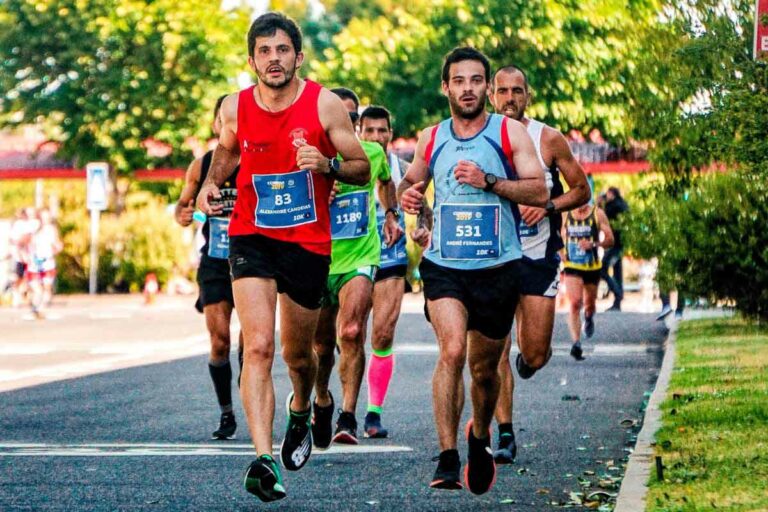Jogging vs. Running: Which Will Help You Lose Weight Faster?

Many of us class ourselves as ‘runners’ or ‘joggers’ either for fun or for the numerous health benefits which are both physical and mental.
Although some people assume jogging and running are the same and use the words interchangeably, there are a few key DIFFERENCES such as pace and physical exertion.
- Running and jogging are often used interchangeably.
- The term jogging usually refers to running at a relaxed pace.
- The main differences can be boiled down to a few factors, such as pace, movement, and mindset.
If you’re UNSURE whether you are a runner or jogger or are just keen to find out a little more if you’re starting a new hobby, we’ve done the work for you.
What Are The Differences Between Jogging And Running?
1. Slow Pace Distinguishes Jogging
Jogging is defined as running at a steady, gentle pace typically less than 6 mph.
On the other hand, running occurs at a much faster pace than jogging, defined as anything over 6 mph.
For example, in a non-competitive setting, an in-shape runner completes one mile in 9 to 10 minutes on average.
Runners also calculate their pace usually in order to beat personal best times and improve their endurance (read more: What Does Pace Mean In Running).
It is important to consider that pace is also dependent on the conditions the activity is taking place in.
You wouldn’t say someone who has done a 10K through a densely wooded area went for a jog. So the pace is too SIMPLE to define a runner from a jogger alone.
2. Arm Movement And Stride Length Are Different
From a distance, two individuals running and jogging beside each other may appear to be doing the same motions.
When you’re running at a faster pace, longer STRIDES mean your feet actually spend less time touching the ground as you propel yourself forward.
Runners also have rapid, mechanical arm movements that help them maintain their quicker pace.
In comparison, joggers tend to keep their legs lower and arm movement smaller making it less strenuous with less physical exertion.
The basic form should still be MAINTAINED with your head up and posture upright.
Running with poor form can lead to injury. A running coach or professional can provide valuable advice if you have problems with your running form.
3. Running Requires More Physical Effort
Running and jogging are forms of aerobic exercise which means your body is using oxygen to produce energy.
As running requires a faster pace it, therefore, requires more physical effort from your muscles, heart, and lungs which can be tough on your body.
Jogging is generally slower and less impactful, working at around 60% of your maximum effort level.
Jogging can last longer which can help with endurance and stamina. It is considered a low to moderate-intensity level exercise.
4. Running or Jogging for Weight Loss?

As each activity requires a different amount of energy, the number of calories burnt differs.
Running/jogging speed, your weight, and terrain have a SIGNIFICANT impact on how many calories you burn. That’s why you get many different answers when figuring out how many calories you burned.
But for comparison, we can think of these numbers for an average person:
- Walking at 3.5 mph burns 300 calories per hour.
- Jogging burns 400-600 calories per hour.
- Running burns 600-1200 calories per hour.
On average, running a 5K will take a runner between 28 to 37 minutes and burn between 300 to 400 calories.
Overall, running burns more calories than jogging making it more effective for burning total body mass.
Runrepeat has analyzed the number of calories burned running from every angle.
5. Health Benefits of Moderate-Intensity Jog
Regular exercise is proven to help you live a healthier, happier life.
Exercise REDUCES the risk of developing diseases such as type 2 diabetes, dementia, and depression. It also helps improve SLEEP quality and therefore increases your energy levels.
Any regular exercise will provide you with a number of health benefits.
- When comparing jogging and running there isn’t a clear option on which is better for your health, this is dependent on your goals and needs.
- They both engage the same muscles but running demands them to work harder. This type of exercise is therefore considered to be a full-body exercise.
- As running requires you to work harder it can come with additional benefits such as burning more calories and aiding weight loss through an increased metabolic rate.
Both running and jogging help to maintain a healthy weight or lose weight if needed. Further, they both strengthen muscles and bones.
Some researchers state that a moderate-intensity jog might be better.
The basic idea behind this theory is that you REACH a certain limit with aerobic exercise, after which the health benefits decrease.
So going for a moderate-intensity jog 2-3 times per week can be optimal for longevity according to The American College of Cardiology, among other health benefits.
Is It Better to Run or Jog?
If you’re just starting to get into exercise and have decided to take up running it’s important that you speak to your doctor before starting a program to avoid injury.
Start with jogging. It can be a beneficial first step to help you manage the stress on your body. If you are OVERWEIGHT this is a highly recommended place to start.
Many people who have taken a break from running or have been injured find that jogging helps to slowly increase their strength and endurance.
This will help you get back into a regular routine that isn’t too intense.
Jogging has a lesser impact on the joints and muscles making it a sensible option for those who suffer from joint issues like arthritis or medial tibial stress syndrome (“shin splints”).
If you are concerned about any pains you feel whilst running (or jogging) it’s important to talk to your doctor to prevent a long-term injury.
The Bottom Line
Jogging is widely perceived as a leisurely activity with no goal in mind compared to running.
Running is commonly associated with defined plans and training for particular events.
Remember that variety is good if you want to improve your running speed and endurance. The benefits of jogging 30 minutes a day are great, but if you don’t vary what you do, you’ll eventually reach a plateau.
If you want to go further, there are many different running workouts to try, like tempo runs, intervals and fartlek runs.





